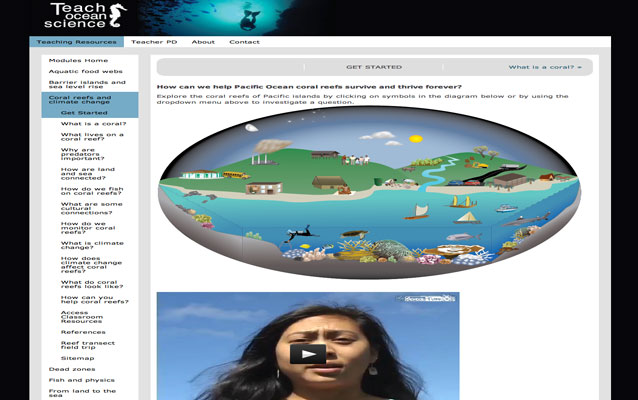Lesson Plan
Coral Reefs and Climate Change in the Pacific Islands Web Module

- Grade Level:
- Sixth Grade-College Undergraduate Level
- Subject:
- Climate Change, Earth Science, Marine Biology, Regional Studies
- Duration:
- Depending on the needs of your classroom, you can pick and choose between lessons and focused learning. Lessons can be completed individually in a single class period, or spread out over several class periods. Field trips and exercises are optional.
- Group Size:
- Up to 24
- Setting:
- classroom
- National/State Standards:
- The standards that each lesson plan fulfills are indicated on the pdfs in the Access Classroom Resources section.
- Keywords:
- Corals, coral reefs, climate change, islands, pacific, science, monitoring, culture, acidification, bleaching, Fish
Vocabulary
There is a considerable amount of vocabulary used in this module. We attempt to address this by making every challenging vocabulary word directly linked to a definition when the mouse is hovered over the vocabulary words.
Overview
This innovative, web-based educational module communicates climate change and coral reef science through inquiry and observation in the Pacific islands. Specifically designed to allow students to choose their experience, the module uses games, videos, and animations to help users observe reef ecosystems and inspire them to develop their own questions. Activities address sustainable fishing, traditional land use practices, and other cultural, natural, and scientific connections to the resources.Objective(s)
Students will learn about corals and how coral reefs form. They will also learn about climate change, the greenhouse effect, ocean acidification, and coral bleaching. In addition, they will learn about marine food webs and the connectivity between the ocean and land. They will learn aspects of natural resources monitoring science in the ocean, and explore the marine realms of four national parks. Finally, they will learn about certain cultures’ relationships with marine resources.
Background
Go through the web module to learn about the various aspects of the program. The teacher can pick some or all of the sections of the module, depending on specific needs. Generally, the teacher should have a basic understanding of climate change and coral reef ecology.
Materials
No physical materials are provided, but all are easily procured. Lesson materials and background are fully integrated and available in the web module.
Procedure
Procedures for lessons, webquests, and field trips can be located at: http://www.teachoceanscience.net/teaching_resources/education_modules/coral_reefs_and_climate_change/access_classroom_resources/?preview=yes#_Coral_Reef_Basics
Assessment
Details of assessment strategy can be found at: http://www.teachoceanscience.net/teaching_resources/education_modules/coral_reefs_and_climate_change/access_classroom_resources/?preview=yes#_Assessment
Park Connections
Case studies of coral reefs are set in the National Park of American Samoa, War in the Pacific NHP (Guam), Kaloko-Honokōhau NHP (Hawaii), and Kalaupapa NHP (Hawaii). The incorporation of these unique parks provides the user varied examples of reef ecosystems and allows the parks to highlight their reefs and associated threats like bleaching and sedimentation. Furthermore, actual Inventory and Monitoring Program benthic cover data is incorporated into the module to lend a real-world element to the scholastic science.
Extensions
This is built into the education module.
Additional Resources
There are further resources for the students to explore in the assessment section.
